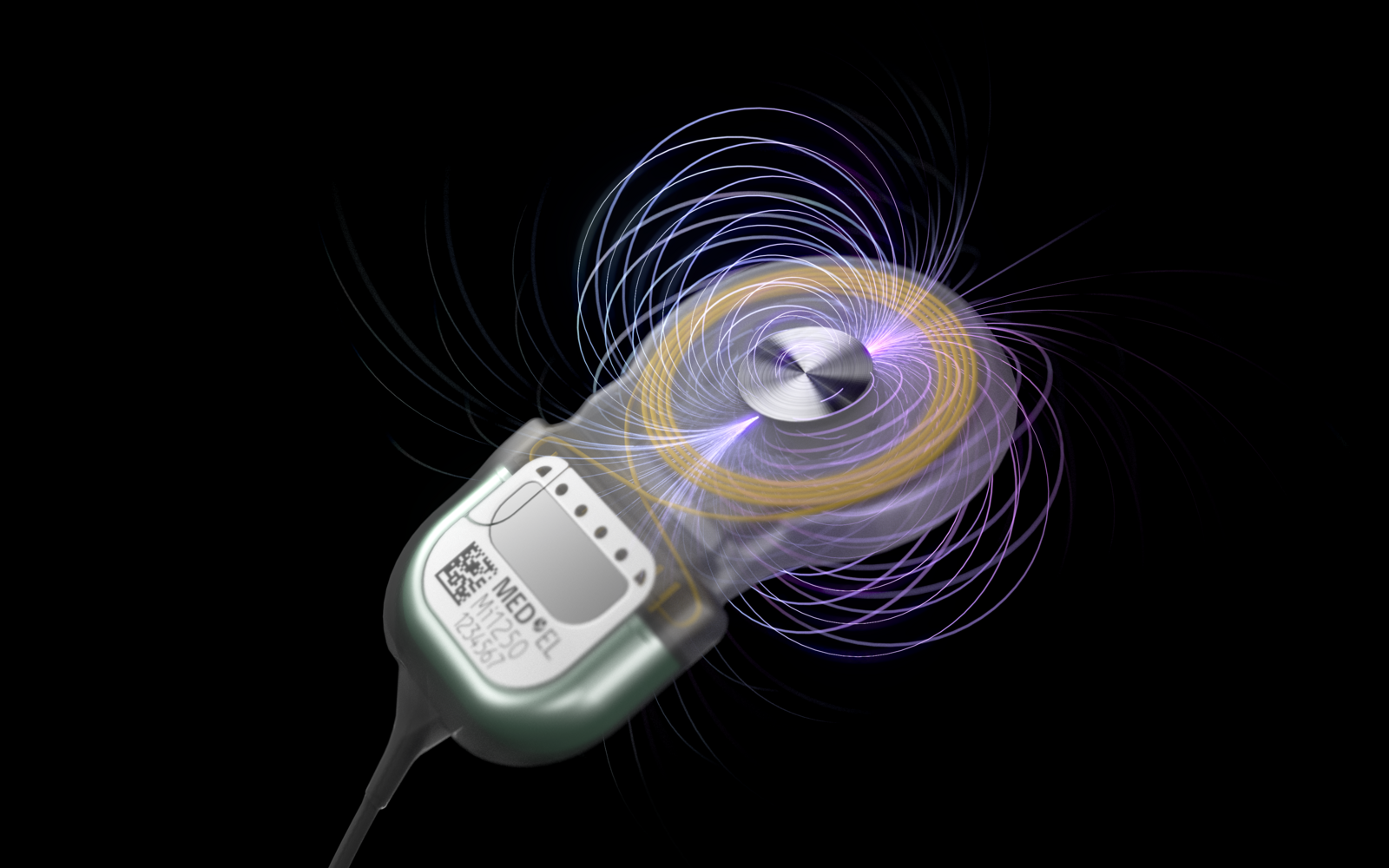MED-EL
Published Jan 28, 2021 | Mar 24, 2025
The Complete Guide to MRI With a Cochlear Implant
Are you scheduled for an MRI and wondering how it will affect your MED-EL cochlear implant? Look no further: Our comprehensive guide answers all your questions about MRI safety, preparation, and what to expect during the scan.

Have you just been told you need an MRI? Not sure what to expect? Well if you have a MED-EL cochlear implant, there’s nothing to worry about! We’ve put together a list of the most commonly asked questions about MRI and cochlear implants, so you can prepare yourself for your scan, and discover why MED-EL offers outstanding MRI safety.**
What is an MRI exactly?
MRI stands for Magnetic Resonance Imaging. An MRI scan is a test carried out by medical professionals so that they can see inside your body. There are many reasons why people get MRIs. It could be that your doctor wants to diagnose a disease or condition, scan your body after an accident, or maybe it’s a follow-up scan after a surgical procedure. MRIs are very common—it’s estimated that all of us will need an MRI at some point in our lifetime.

What happens during an MRI?
First, you will lie down on a stretcher, which slides into the middle of a human-sized tube. For imaging, you will be asked to lie very still so the MRI technologist can get the best image possible. The technologist will be in the next room, but they can see and hear you at all times via a camera and microphone. You will have a signal button which you can press in case you feel uncomfortable, and the technologist can also come into the MRI room if you need assistance during the scan.
How long does an MRI take?
That depends on lots of things, such as the part of your body being scanned, the type of machine, and the resolution of the scan. It can be anywhere between 15 and 90 minutes—your doctor will be able to give you an idea of how long your particular scan will last.
Can I have an MRI with my cochlear implant?
YES! All MED-EL cochlear implants can undergo MRI scans at 1.5 Tesla, the low-definition scan resolution. And with our latest cochlear implants, SYNCHRONY and SYNCHRONY 2, you can even have high-definition scans at 3.0 Tesla**.
Why is that possible with SYNCHRONY series implants?
MRI machines have really powerful magnets, so powerful they could lift a car! Unfortunately, these strong magnetic forces can also pull on the small magnet in your cochlear implant. If the magnet is pulled on too much it can be ripped out of place—damaging your implant, and most likely causing you pain.
But the unique design of our SYNCHRONY series’ magnet means that it isn’t affected by the magnetic forces, and therefore cannot be ripped out of the implant during the scan.
Can I wear my audio processor during the scan?
Unfortunately not, as the MRI machine could damage your processor. The same goes for earrings, watches, hearing aids, false teeth, and any other items containing metal.

MED-EL's SYNCHRONY 2 cochlear implant has a unique design which isn’t affected by the magnetic forces of an MRI machine
Will I feel my implant during the scan?
Most people, particularly those with SYNCHRONY or SYNCHRONY 2, say they don’t feel their implant at all during an MRI. Some people report hearing a small ticking noise during the scan. The unique design of our SYNCHRONY magnet means you won’t feel any pain or even “tugging” while you’re in the machine. If you want a first-hand account of what it’s like to have an MRI with a cochlear implant, check out Kim’s Story.
I heard MED-EL offers an MRI guarantee. How does that work?
Quite simply, our MRI guarantee covers your MED-EL cochlear implant against damage during an MRI scan. The MRI guarantee is life-long and automatically valid worldwide for all our multichannel cochlear implants since 1994.*
Great Protection. Guaranteed.
Because of our long and positive experience with MRIs and cochlear implants, we’re the only hearing implant company to offer a life-long MRI guarantee. We promise to replace your implant in the very unlikely event that it’s damaged during an MRI scan.*
- Valid for all MED-EL cochlear implants since 1994
- Life-long and worldwide
- The first and only to be offered by any hearing implant company.
My friend with a cochlear implant was told they couldn’t have an MRI. Were they wrong?
Not necessarily. If your friend needed an MRI over a decade ago, this may have been the case. Cochlear implant technology has moved on a lot in recent years.
Alternatively, your friend might have a CI from a different company. Different cochlear implants have different MRI conditions, so an MRI may not have been possible with your friend’s implant. If you have a CI from a company other than MED-EL, you should talk directly to that company to find out whether you can have a scan or not.

“I had another brand of implant and had a magnet pulled out of my head, so I know how important is to have an MRI.”
Helen
MED-EL cochlear implant user
I tried to book an appointment for an MRI, but was told I couldn’t have one with my CI. Help!
However amazing your radiologist or doctor is, they cannot be expected to know detailed information about every medical product available. You could be the very first CI patient they’ve ever seen, so they might not know how best to proceed.
If you are told you can’t have an MRI scan, ask your clinic to talk directly to the MED-EL team in your country. They will be able to explain which scans are possible with your cochlear implant, and answer any questions your clinic may have. It may also help to download the MED-EL Important Safety Information for your country, and show this to your radiologist or clinic.
I heard I have to have the magnet surgically removed before getting an MRI. Is this true?
Not with MED-EL, no! All our implants are approved for MRIs at 1.5 Tesla without any extra surgery to remove the magnet. As we said before, our SYNCHRONY and SYNCHRONY 2 implants are even approved for 3.0 Tesla scans, again without any magnet removal surgery required.***
This means you can simply book your appointment, and have your MRI like any other patient. There are no extra hospital visits for surgery and follow up, and no hearing downtime.
I also heard that a 1.5 Tesla MRI is good enough for most medical problems. What’s the big deal with 3.0 Tesla?
A 1.5 Tesla MRI is certainly very good, but there may be situations where a doctor would prefer a 3.0 Tesla scan, if possible. A scan at 3.0 Tesla is more detailed than at 1.5 Tesla, so the doctor can more clearly see what’s going on inside you. This can lead to a faster diagnosis, more effective treatment, or better monitoring of your condition. In the words of esteemed CI surgeon Dr Harold Pillsbury: “3.0 T is the gold standard”. Another aspect is that over the past few years some clinics have exchanged their 1.5 Tesla scanners with 3.0 Tesla scanners. So it is good if your implant is also able to withstand a 3.0 Tesla MRI.
“3.0 T is the gold standard”
Dr Harold Pillsbury
Cochlear implant surgeon
What’s this head bandage I keep seeing pictures of on Facebook?
With some cochlear implants, a bandage needs to be wrapped very tightly around the head during a scan. This helps to keep the magnet in place if it starts to pull away from the implant.
But you’ll be pleased to hear that with MED-EL’s newest implant models, no head bandage is required! Our magnets are designed with MRI in mind, so you do not need a head bandage to keep the magnet in place.
And what about us BONEBRIDGE users! Can we get MRIs too?
Yes, it’s not just cochlear implants that get all the MRI glory. If you have a BONEBRIDGE, you can have MRIs of up to 1.5 Tesla. This is also possible with the latest generation of the VIBRANT SOUNDBRIDGE.** Like with CIs, you won’t need any extra surgery to remove the magnet, and you also won’t need to wear a head bandage.***
So let me get this right. I can have an MRI scan with my implant in the same way as a normal patient, without any magnet removal surgery or head bandage, I shouldn’t feel the implant during the scan, and my implant is guaranteed against any damage? That sounds pretty great!
Yup. That’s why MED-EL is known as “the best for MRI”.
References
MED-EL
Was this article helpful?
Thanks for your feedback.
Sign up for newsletter below for more.
Thanks for your feedback.
Please leave your message below.
Thanks for your message. We will reply as soon as possible.
Send us a message
Field is required
John Doe
Field is required
name@mail.com
Field is required
What do you think?
* The terms and conditions of the MRI guarantee can be found here.
** All MED-EL implants listed in this article are MR conditional. Recipients with a SYNCHRONY 2 Cochlear Implant may be safely MRI scanned at 0.2, 1.0, 1.5, and 3.0 Tesla following the conditions detailed in the medical procedures manual. Recipients with a SYNCHRONY Brainstem Implant (ABI) may be safely MRI scanned at 0.2, 1.0 and 1.5 Tesla following the conditions detailed in the medical procedures manual. Recipients with BONEBRIDGE may be safely MRI scanned at 1.5 Tesla following the conditions detailed in the instructions for use. Recipients with the SOUNDBRIDGE VORP 503 implant may be safely MRI scanned at 1.5 Tesla following the conditions detailed in the instructions for use.
*** Unless required for diagnostic reasons
© MED-EL Medical Electronics. All rights reserved. The content on this website is for general informational purposes only and should not be taken as medical advice. Contact your doctor or hearing specialist to learn what type of hearing solution suits your specific needs. Not all products, features, or indications are approved in all countries.
ANGELA MARIA PUGLIESE
May 24, 2023
Necesito informacion Muchas gracias. Angela
MED-EL
May 25, 2023
Hi Angela, thanks for reaching out. Please contact your local MED-EL team for any questions you have on our products. You can find them here: https://www.medel.com/clinic-finder Kind regards, Gordana
Joel
September 08, 2023
MRI Technologist here- the MRI scanner is always on (this article mentions it will be switched on during the exam). Also, a Technician might be someone who repairs MRI scanners, but a Technologist is the person positions and acquires the images.
MED-EL
September 13, 2023
Hi Joel, thanks a lot for your comment and for spotting this mistake! We have corrected it in the article. Kind regards, Gordana
Rafael Rodriguez
December 08, 2023
How much artifact can we expect when scanning MRI of brain thin slice for surgical planning? Will the images be diagnostic? How much will the implant affect the quality of DWI imaging for Brain on patients that have this implant?
MED-EL
December 12, 2023
Rafael, thank you for your question. EPI-DWI sequences are non-diagnostic due to imaging artifacts with any cochlear implant. However, with the SYNCHRONY, SYNCHRONY ST, SYNCHRONY 2, and SONATA 2 implant, there is the option to surgically remove the implant's magnet to reduce susceptibility artifacts. The imaging artifact is smaller with a non-EPI DWI sequence (e.g., HASTE). Using metallic artifact reduction sequences can also help. We cannot give a single number for the size of the susceptibility artifact because it depends not only on the sequence type but also on sequence parameters. Several publications show the size of susceptibility imaging artifacts for different imaging sequence types with our cochlear implants. You may also be interested in reading more on our blog for Professionals here: https://blog.medel.pro/products-updates/3t-brain-mri-synchrony-cochlear-implant/. Kind Regards
Rotem Perlmutter
May 16, 2024
Hello! Is there any documentation about the ability to acquire proper imaging of the brain stem, even without removing the magnets from the implants? As it is a medial structure? Or does the masking from the magnets distort the brain stem region as well?
MED-EL
May 23, 2024
Hi Rotem, thanks for your question. There are peer-reviewed scientific publications available which state that radiologic assessment of the brainstem, the internal auditory canal and the cerebellopontine-angle is usually possible also when one or two SYNCHRONY cochlear implants with magnet(s) is/are in place. In such cases MRI scanning is being performed with metal artifact reducing sequences. Being aware of the potential need of a brainstem MRI, the surgeon might probably place the implant(s) slightly more superior so that the implant magnet is at a distance of 8-9 cm from the outer ear canal. As far as we know from practical experience this works out well, and magnet removal prior to MRI is with SYNCHRONY implant models (also SYNCHRONY ST and SYNCHRONY 2 as well as SONATA 2) rarely needed. We recommend also getting in touch with your surgeon regarding this. If further details need to be clarified we are happy to support. Here are some examples of peer-reviewed publications which would target this topic: Kalmanson O.A., Talmage G.D., Honce J.M., and Gubbels S.P. Effect of Head Position and Magnetic Resonance Sequence on Cochlear Implant–Related Artifact Size and Internal Auditory Canal Visibility Otol Neurotol 44:e73–e80, 2023 https://doi.org/10.1097/mao.0000000000003738 Schwarz-Nemec U., Dahm V., Arnoldner C. Letter to the editor regarding worldwide 1st MED-EL Mi1200 SYNCHRONY cochlear implant magnet removal for MRI image artifact reduction by Wieser et al. Otolaryngology Case Reports 10 (2019) 43–44 https://doi.org/10.1016/j.xocr.2019.02.002 Schwartz N., Rooth M. A., Dillon M. T., O'Connell B.P., Dedmon M.M., Huang B.Y., Brown K.D. MRI surveillance following concurrent cochlear implantation in cases of vestibular schwannoma resection Am J Otolaryngol 41 (2020) 102518 https://doi.org/10.1016/j.amjoto.2020.102518 Shew M., Bertsch J., Camarata P., Staecker H. Magnetic Resonance Imaging in a Neurofibromatosis Type 2 Patient with a Novel MRI-Compatible Auditory Brainstem Implant J Neurol Surg Rep 2017;78:e12–e14. https://doi.org/10.1055%2Fs-0036-1597588 Kind regards, Gordana
Carolyn Burelbach
February 26, 2025
My friend with a cochlear implant was told they couldn’t have an MRI. Were they wrong? Not necessarily. If your friend needed an MRI some time ago, this may have been the case. Cochlear implant technology has moved on a lot in recent years. Please define "some time ago". This isn't a very helpful description.
MED-EL
February 28, 2025
Hi Carolyn, thank you for reaching out. All our SYNCHRONY series cochlear implants are MRI safe for up to 3.0 Tesla without magnet removal. If you have any further questions, we recommend getting in touch with your local MED-EL team via https://www.medel.com/contact-med-el Kind regards, Gordana
Karine Bertuol
September 17, 2025
É necessário envolver a cabeça com uma bandagem bem apertada durante o exame. Que tipo de bandagem é essa?
MED-EL
September 18, 2025
Hi Karine, thank you for reaching out. We recommend getting in touch with your medical experts and local MED-EL team for any questions regarding MRI procedures with a CI: https://www.medel.com/pt-br/contact-med-el Kind regards
Martí Pastells Sanxis
October 09, 2025
Buenas tardes llevo un implanten coclear de su marca y debido a un problema de salud han de realitzar me una resonància magnètica , lan parte interna és el modelo CONCERTO FLEX 28. La pregunta és que en el centro medico quieren asegurarse de no provocar ninguna daño. Serian tan amables de poder enviarme documentacions para darsela a los tècnicos para que ellos lo tengan mas claror. Gràcias de antemano. Martí Pastells
MED-EL
October 10, 2025
Hi Martí, thank you for reaching out. We recommend getting in touch with your medical experts as well as your local MED-EL team for further assistance. Please contact your local MED-EL team directly via https://www.medel.com/latam/contact-med-el Kind regards
MED-EL
.png)



Conversation
7 Comments